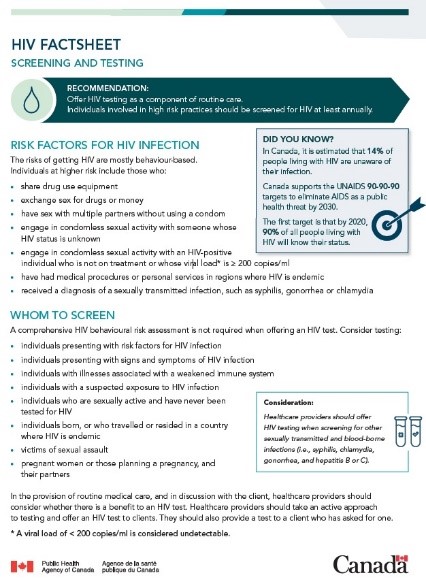HIV factsheet: Screening and testing

Download the alternative format
(PDF format, 151 KB, 2 pages)
Organization: Public Health Agency of Canada
Date published: November 2019
Recommendation
Offer HIV testing as a component of routine care. Individuals involved in high-risk practices should be screened for HIV at least annually.
Risk factors for HIV infection
The risks of getting HIV are mostly behaviour-based. Individuals at higher risk include those who:
- share drug use equipment
- exchange sex for drugs or money
- have sex with multiple partners without using a condom
- engage in condomless sexual activity with someone whose HIV status is unknown
- engage in condomless sexual activity with an HIV-positive individual who is not on treatment or whose viral loadFootnote * is ≥ 200 copies/ml
- have had medical procedures or personal services in regions where HIV is endemic
- received a diagnosis of a sexually transmitted infection, such as syphilis, gonorrhea or chlamydia
Whom to screen
A comprehensive HIV behavioural risk assessment is not required when offering an HIV test. Consider testing:
- individuals presenting with risk factors for HIV infection
- individuals presenting with signs and symptoms of HIV infection
- individuals with illnesses associated with a weakened immune system
- individuals with a suspected exposure to HIV infection
- individuals who are sexually active and have never been tested for HIV
- individuals born, or who travelled or resided in a country where HIV is endemic
- victims of sexual assault
- pregnant people or those planning a pregnancy, and their partners
In the provision of routine medical care, and in discussion with the client, health care providers should consider whether there is a benefit to an HIV test. Health care providers should take an active approach to testing and offer an HIV test to clients. They should also provide a test to a client who has asked for one.
Consideration
Health care providers should offer HIV testing when screening for other sexually transmitted and blood-borne infections (i.e., syphilis, chlamydia, gonorrhea, and hepatitis B or C).
Did you know?
In Canada, it is estimated that 14% of people living with HIV are unaware of their infection. Canada supports the UNAIDS 90-90-90 targets to eliminate AIDS as a public health threat by 2030. The first target is that by 2020, 90% of all people living with HIV will know their status.
Signs and symptoms
Individuals may develop mild flu-like symptoms 2 to 4 weeks after becoming infected with HIV. During the window period, antibodies are not detectable, and there are high levels of HIV in blood and genital secretions. Early diagnosis and linkage to care are significant steps in preventing onward transmission. Treatment should be offered upon diagnosis.
Primary acute HIV infection
Upwards of 50% of individuals with acute HIV infection may have non-specific symptoms like fever, fatigue, muscle aches and headache. Misdiagnosis of acute infection is common.
Acute or early HIV infection may account for around 50% of secondary infections (i.e., incident cases).
A fourth generation test can detect HIV infection within 15 to 20 days.
Consideration
Clinicians should maintain a high index of suspicion for HIV infection, and offer an HIV test to individuals with a non-specific febrile illness and/or a history of high-risk behaviour.
Chronic HIV infection
Chronic HIV infection is often asymptomatic for years.
During this stage, the virus continues to replicate at very low levels. Individuals who are unaware of their infection are at increased risk of negative health outcomes and are more likely to transmit HIV to others.
Late diagnosis of HIV infection
It is estimated that 25% to 50% of individuals are diagnosed late in the course of HIV infection.
Symptoms of late infection include: rapid weight loss, pneumonia, and severe and persistent diarrhea.
Many individuals diagnosed with late HIV infection have had multiple contacts with the healthcare system, during which they were not tested for HIV. Capitalizing on opportunities for HIV screening and testing allows for early diagnosis, linkage to care, and treatment leading to improved health outcomes and decreased
onward transmission.
Additional resources
- Public Health Agency of Canada's HIV Screening and Testing Guide
- Public Health Agency of Canada's Review on HIV Risk of Transmission
- Government of Canada: HIV and AIDS for Health Professionals
- Canadian Guidelines on Sexually Transmitted Infections
- CATIE HIV in Canada: A Primer for Service Providers
- UNAIDS: Undetectable = Untransmittable Public Health and HIV Viral Load Suppression (PDF)
Footnotes
- Footnote *
-
There is effectively no risk of sexual transmission of HIV when the viral load is < 200 copies/ml.